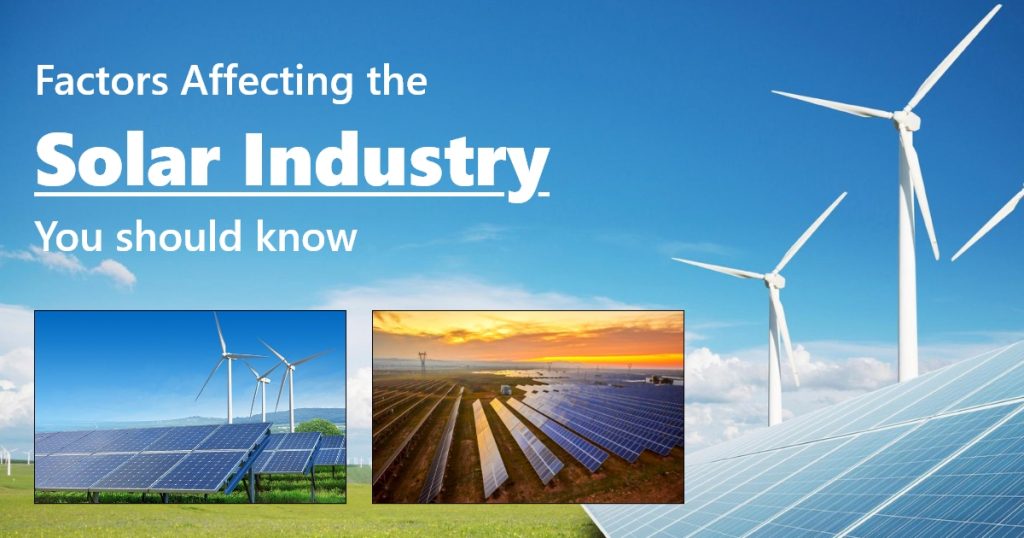Factors Affecting the Solar Industry – You Should Know.

Solar power systems are a key tool in current and future generations’ energy supply. Several factors encouraged the development of photovoltaic, such as environmental issues, incentives and tax deductions, better performance, and cheaper technology. But some factors are affecting the solar industry in Fresno.
Let’s Understand the Factors that Affect the Output of the Solar Industry in Fresno:
1. Weather Change
Many of us believe that high temperatures lead to high efficiencies in solar panels, but it is a myth. Heat exposure can degrade solar cells prematurely and lead to a fall in voltage and a decrease in total power for everyday production.
In cold rather than warm climate, solar cells perform better, for example, if solar panels are exposed to 25 /uC, which can vastly differ from the true situation outside
2. Solar Shadings
solar panels are highly susceptible to solar shading. Total or partial conditions of shading have a significant impact on the power supply capability and can lead to lower output and power losses. The solar panel cells are usually connected in series to produce higher voltage and thus adequate electricity production.
But this structure has certain limitations when shading occurs. The current in all the units in the string is determined by the unit which produces the least current when a single solar cell is shaded. The whole series is virtually shaded when a cell is shaded. The system usually includes bypass diodes to prevent energy loss.
3. Roof Orientation
For those living in the Northern Hemisphere, the solar panels installation must be placed southward, and the sun lies on the south side. It is therefore generally the best practice to position solar panels southwards to capture the maximum total sunlight.
The solar panels facing the south should be tilted between 30 and 40 degrees to ensure that sunlight hits the most energy-producing panels at a perpendicular angle behind this angle specialty. Snow also contributes to sliding off from solar panels in northern latitudes more quickly in winter.
4. The tilt of Solar Panels and the Effect on Solar Panel Production
The inclination or tilt of your solar panels can have a significant influence on your system’s overall output. You would prefer to change the inclination of your panels throughout the year because in summer the sun is higher and in winter the sun is lower. But sun-tracking systems are more expensive and require maintenance because they have movable components. You should look for a Solar Power installer in Fresno, the maximum benefits.
Also Read: – How Fresno Has The 3rd Highest Number of Homes in California with Solar Panels Rooftop.
5. Cleanliness of Solar Panel Surface
The solar panels surface is directly connected to the conversion of photoelectric power. Due to the polluted environment, precipitation, snow, dust, and sandstorms have little to do in reducing solar modules, thus ensuring that the solar panels have a cleaning frequency based on their local labor costs.
More pollution in the winter occurs in most places; therefore, spring is the best time to clean every year. When solar panels are cleaned once or twice a year, they produce 3.5% more electricity than unclean ones and 5.1% more electricity
6. Energy Conversion Efficiency
The solar module depends on the type of module and has a different spectral response. This is why the spectral generation of solar energy changes. By reducing the reflection of the incident light, the energy conversion efficiency is increased and this works effectively in the residential solar systems.
7. Pollution
The amount of solar energy generated can be reduced by pollution and dirt. Urban air pollution, forest smoke, and volcanic air-borne ash can reduce solar resources by increasing solar radiation dispersal and absorption.
Because solar panels collect light, anything that obscures the passage of light, such as dirt, might have an impact on the energy supply. While dust on solar modules can build-up, solar panels are usually self-cleaning. Mother Nature can in most cases do her job and let the rain clean up the modules
8. The Orientation, Inclination, Latitude of the place and Climatic conditions
Some factors to take full advantage of solar radiation have to be considered when installing the photovoltaic modules: the position, the inclination, latitude of the place, climate conditions. Correct examination of these variants will help ensure that maximum energy is produced by being exposed for the longest period to the maximum intensity of solar radiation.
9. Location
Not every site has the same amount of sunshine every year. It is a tough job, in designing an economical solar range to decide the amount of solar radiation received in your home. When it comes to Solar Panels in Fresno insulation is defined by the latitude of your home or company elements such as local weather, the time of year, and more significantly.
Also Read: – How Much Do Solar Panels Cost in Los Angeles, California?
Conclusion –
Knowing what factors affect the solar industry in Fresno is important to ensure that you get the most profit possible out of your solar panels system.
What's New in the Solar Industry for 2021? SolarQuery
July 6, 2021 at 11:18 am[…] >>>Also Read- Factors Affecting the Solar Industry – You Should Know.<<< […]